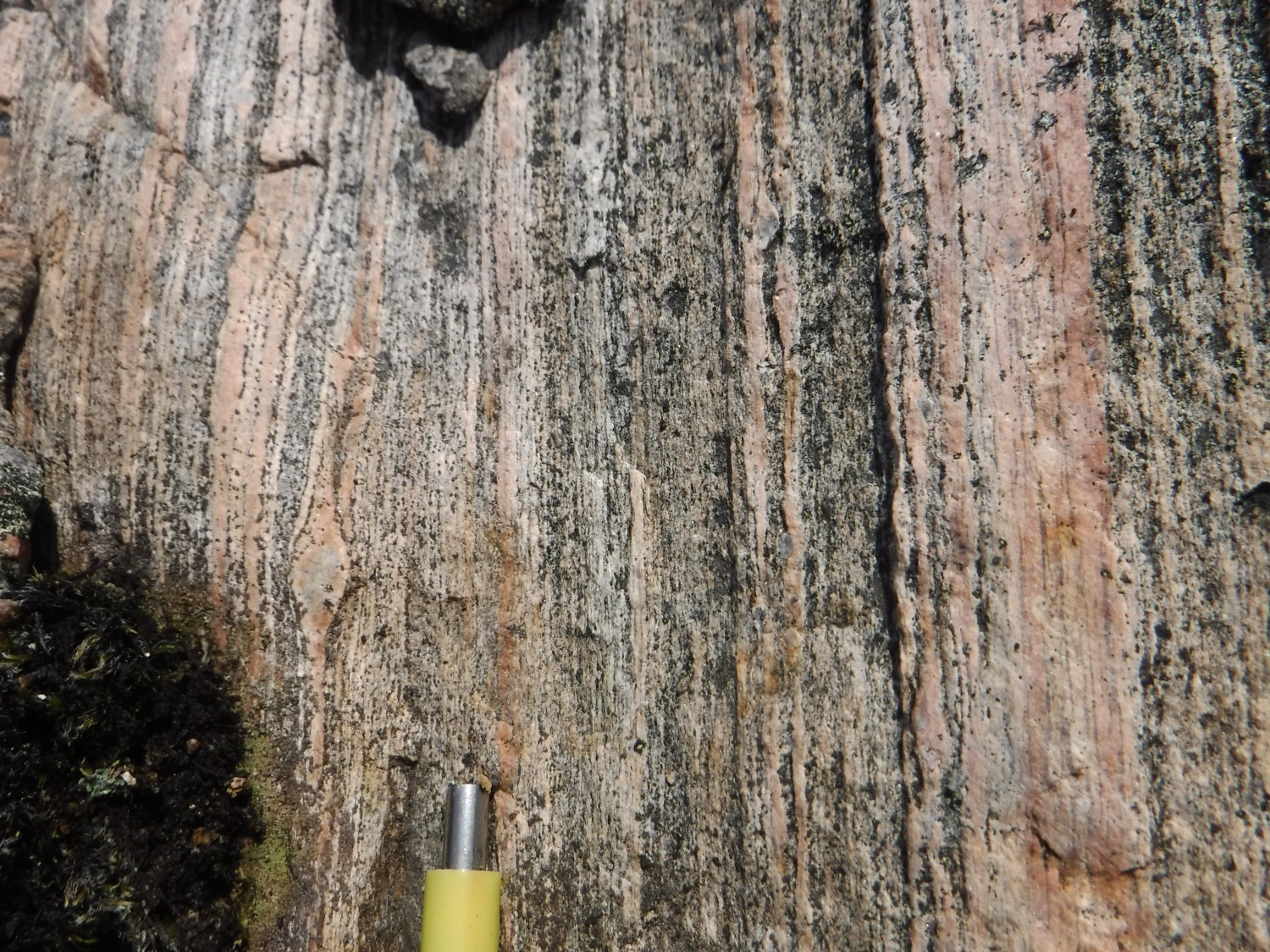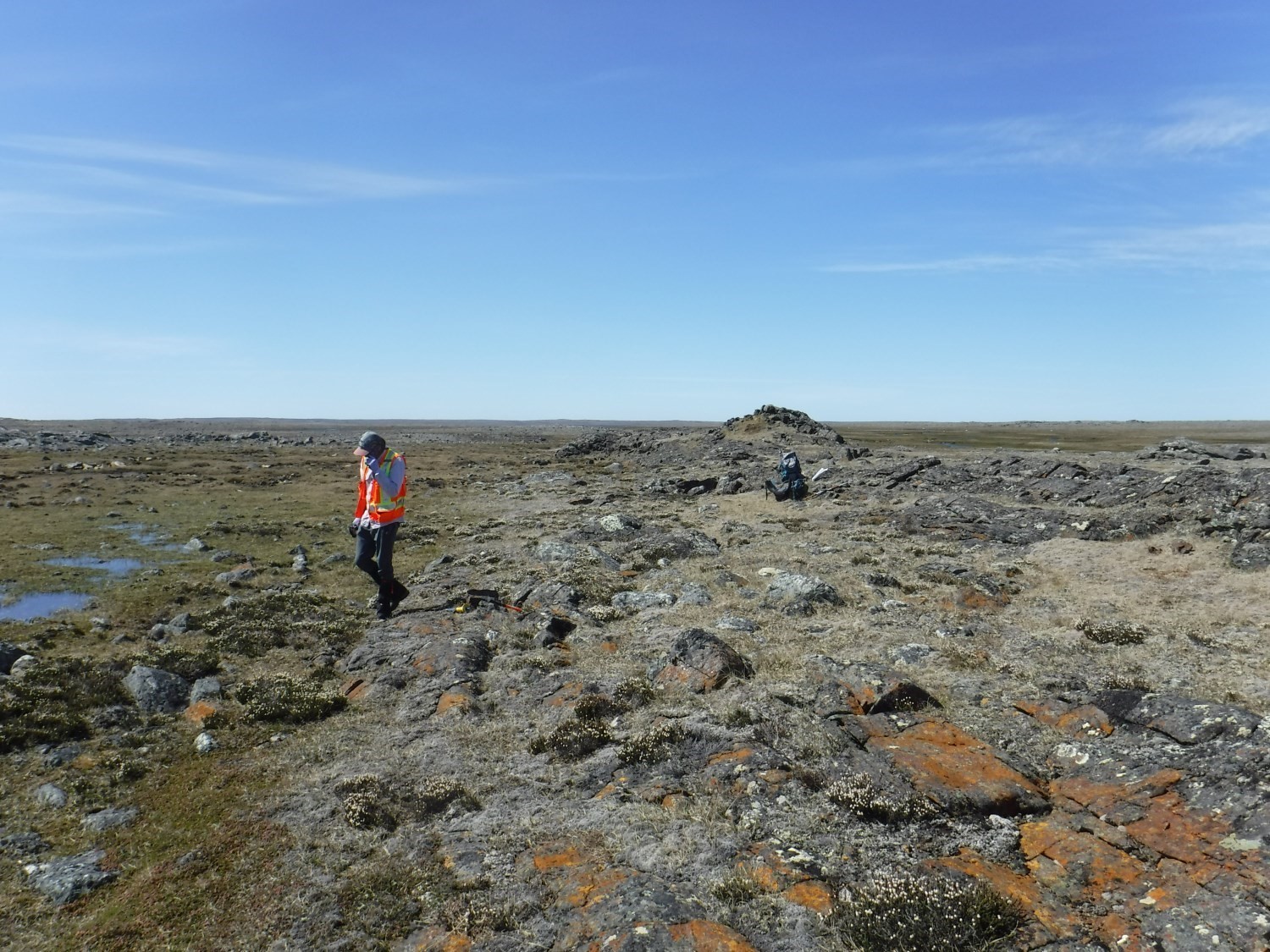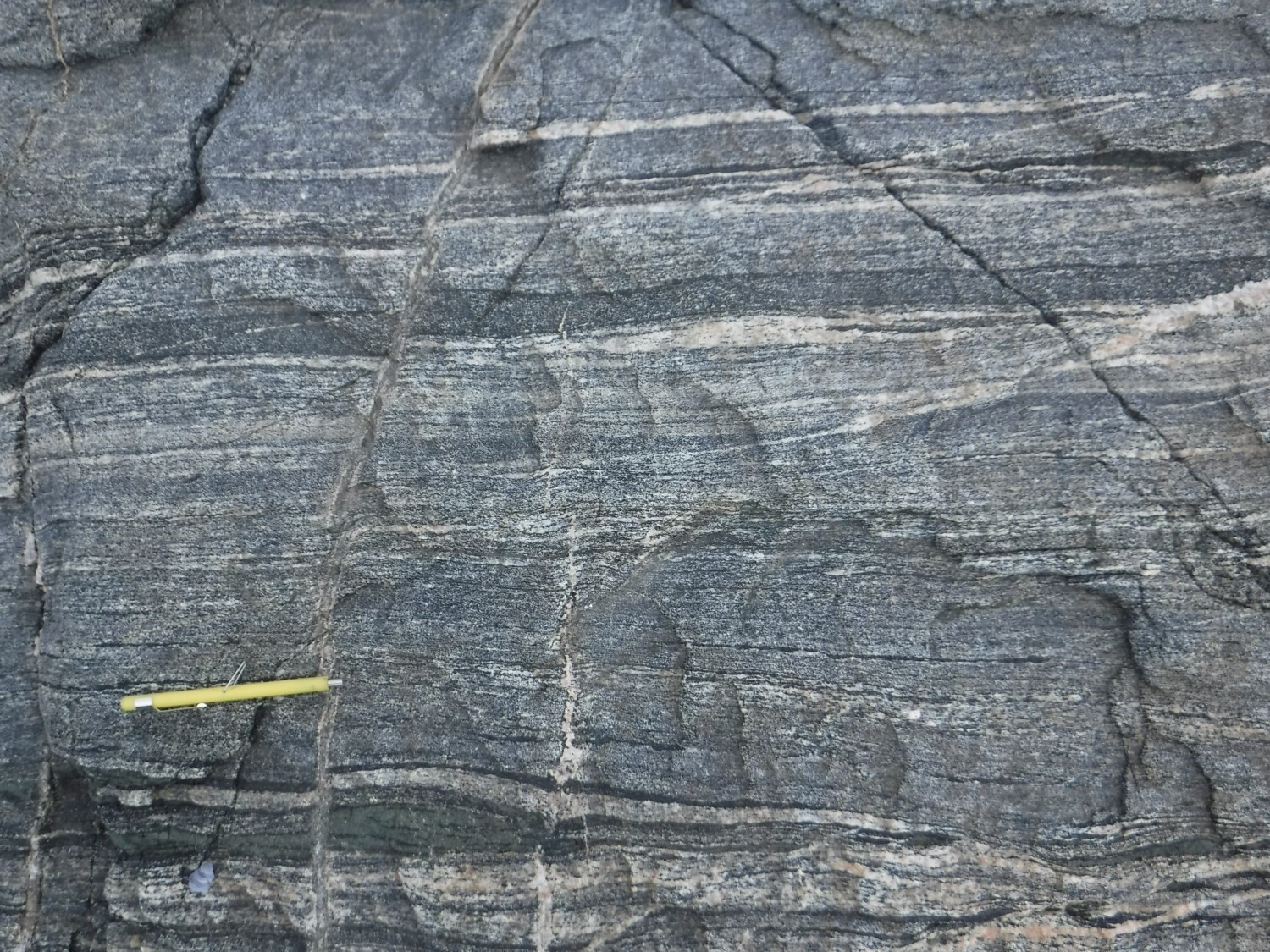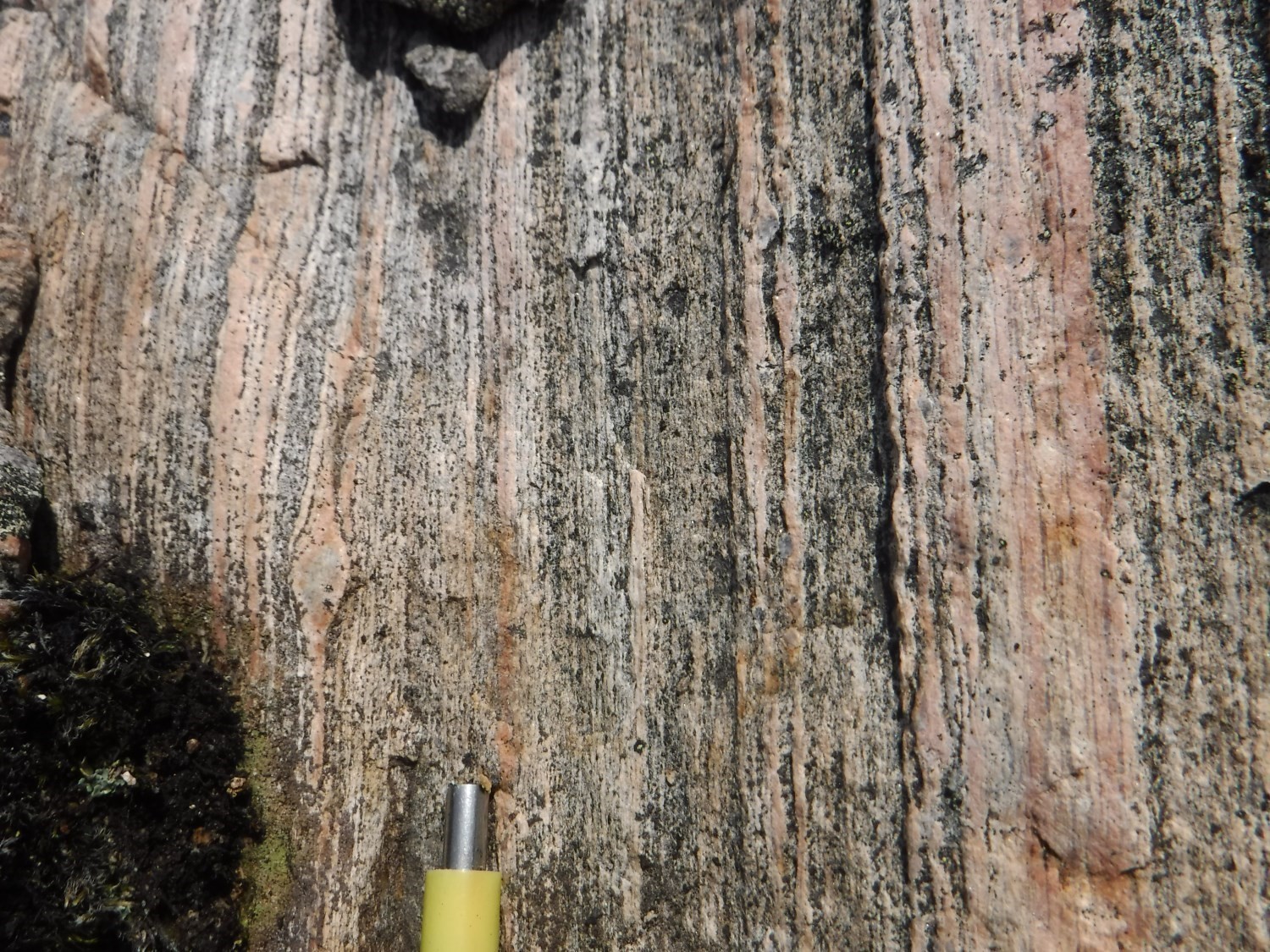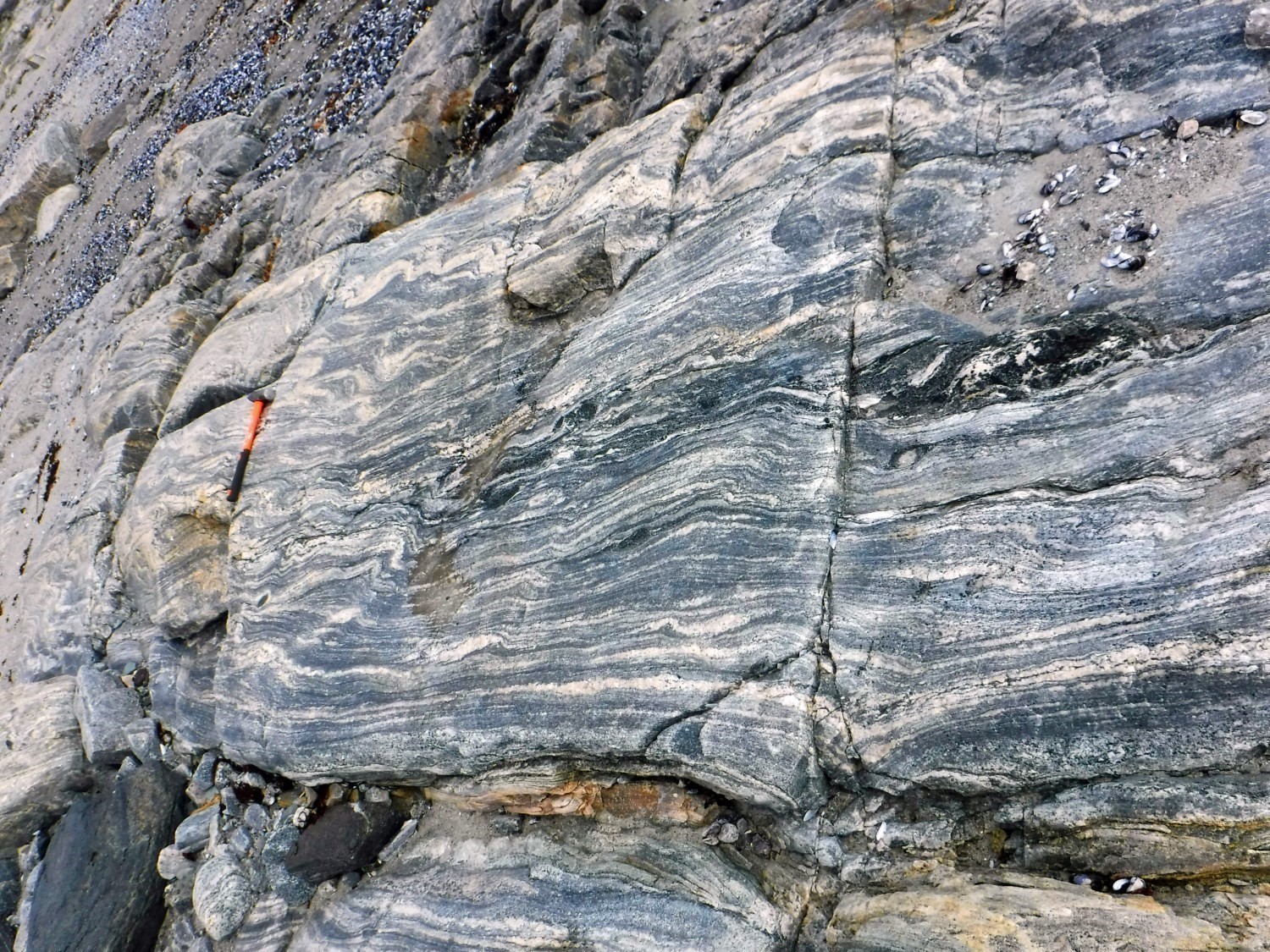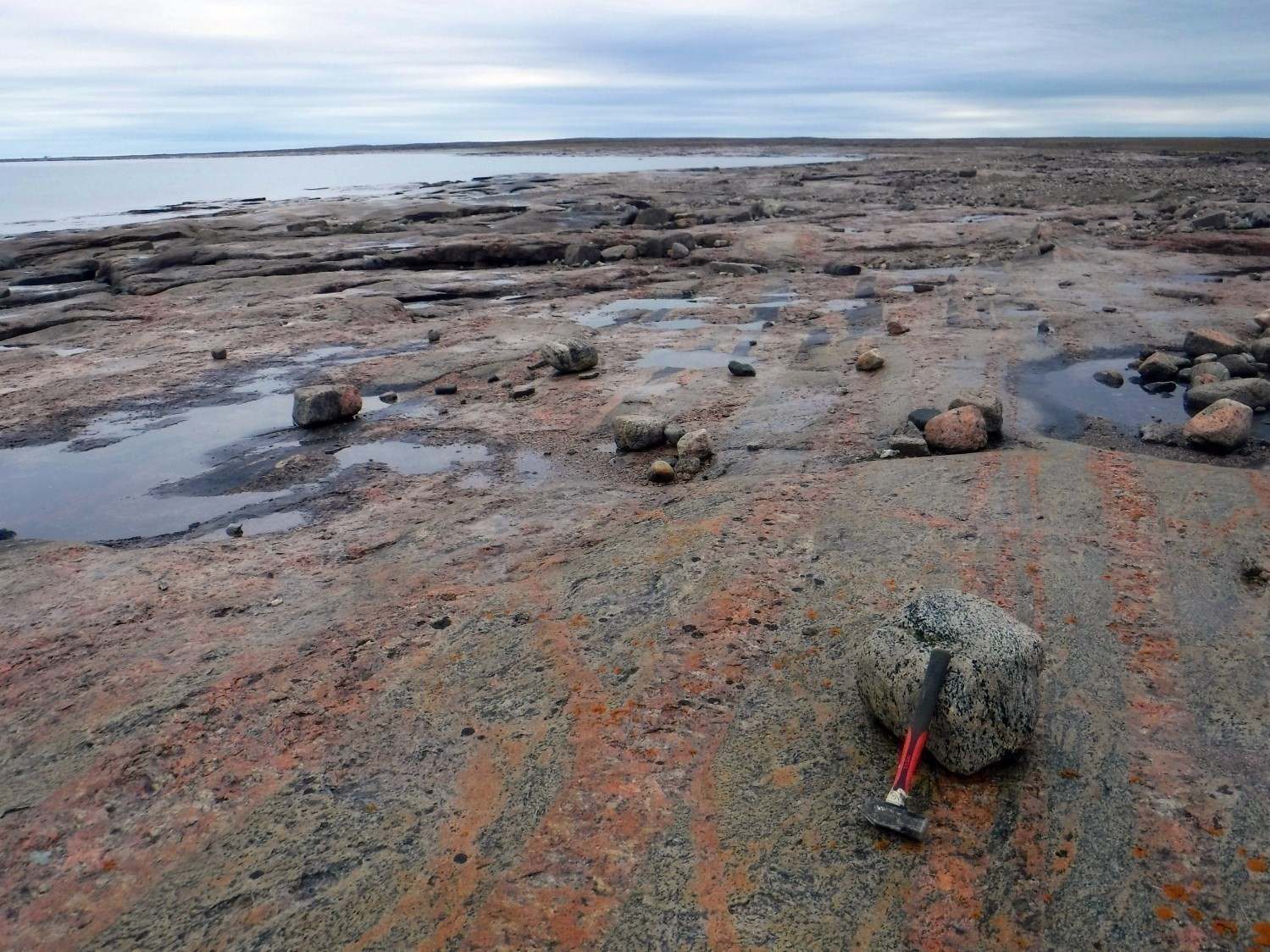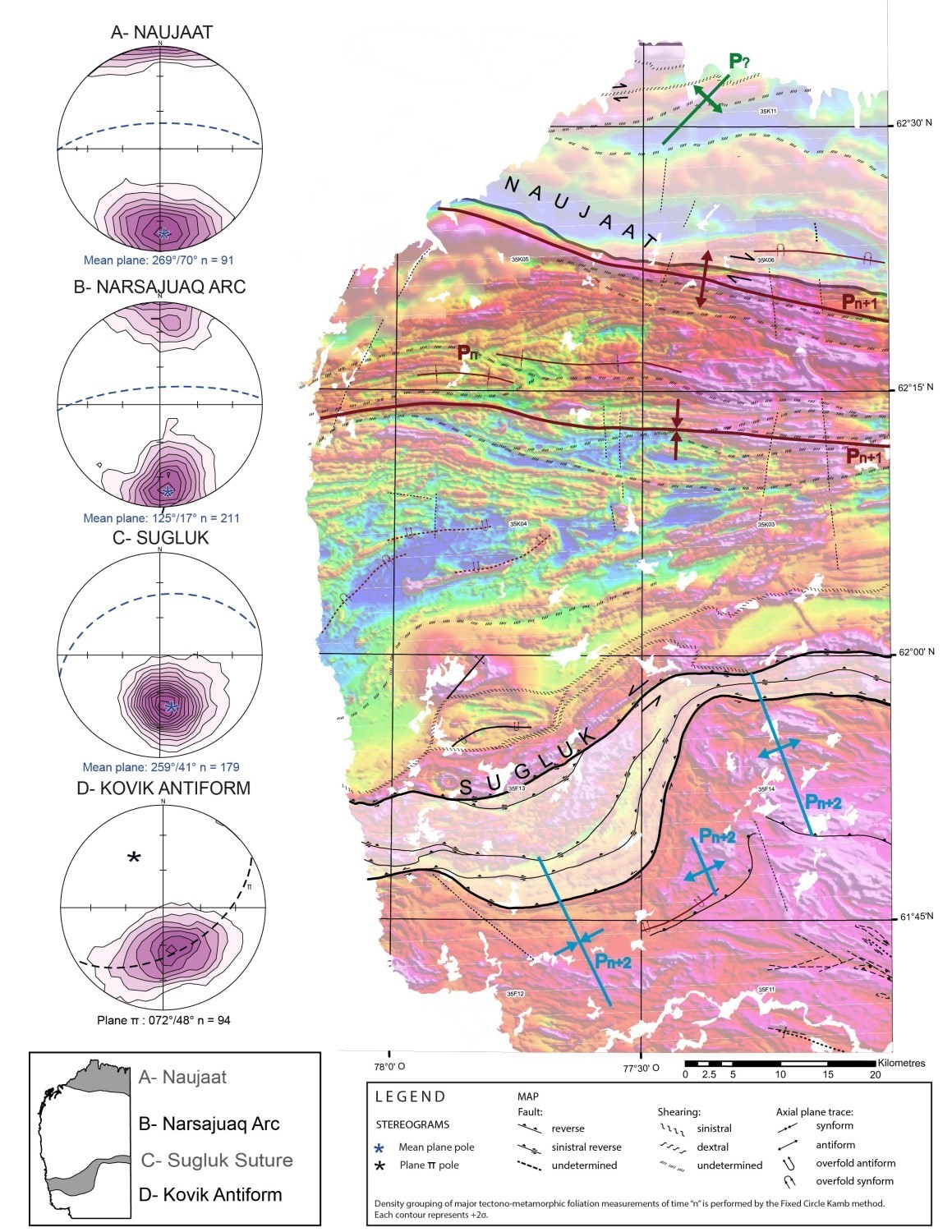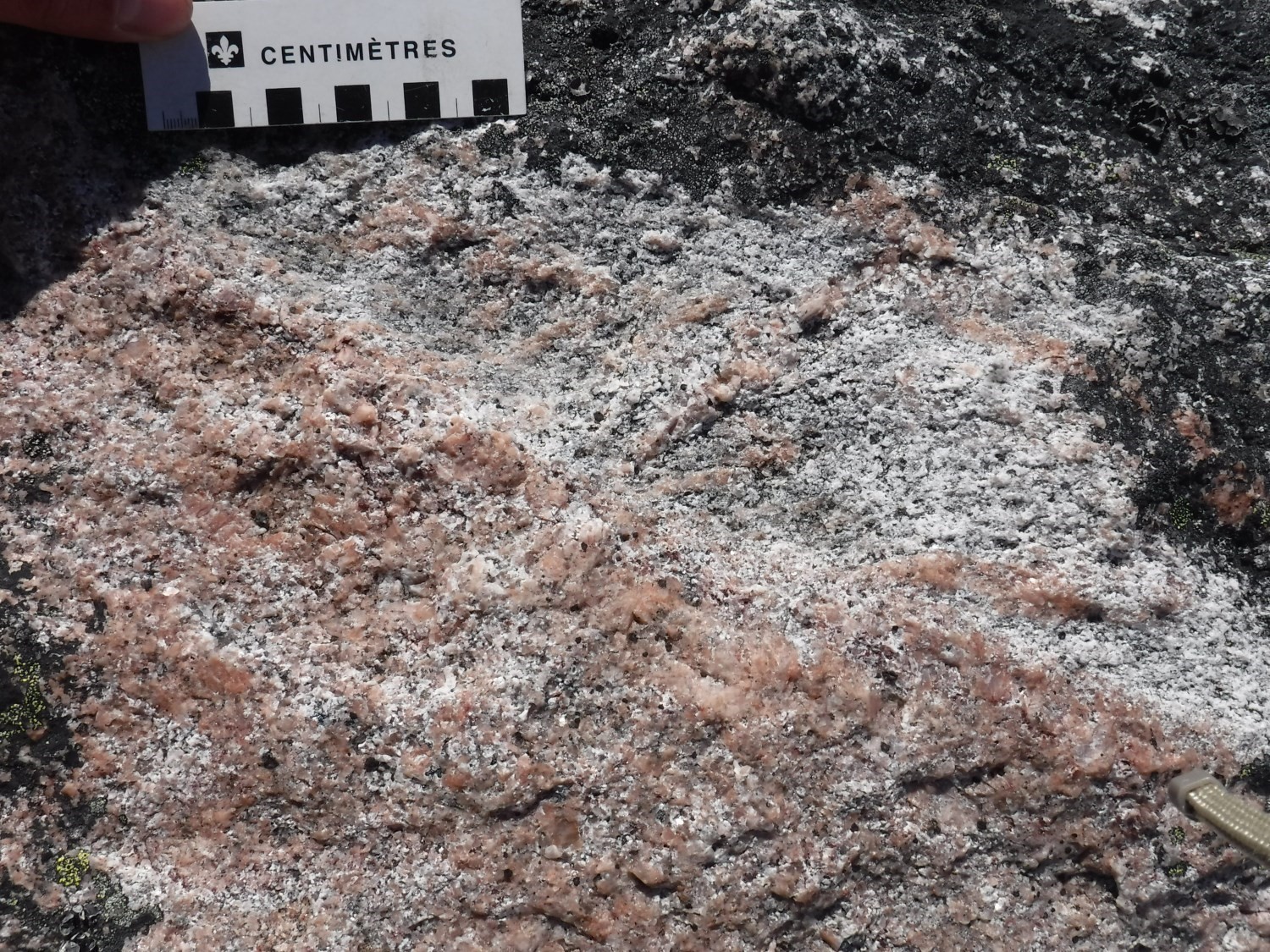
Geology of the Cape Wolstenholme Region, Ungava Orogen, Churchill Province, Southeast Ivujivik, Quebec, Canada
Project for NTS sheets 35E, 35F, 35K et 35L
Benoit Charette and Mélanie Beaudette
BG 2018-03
Translated on 20 November 2018
The northwest portion of the Ungava Orogen was mapped to a 1:100,000 scale in the summer of 2017. This geological survey has redefined the boundaries of the Narsajuaq Arc and introduced 16 new lithodemic units forming a complex assemblage. Two regional deformation corridors were identified in the mapped area. To the south, the Sugluk Suture has been redefined as the northern edge of the Kovik Antiform, exposing Archean rocks of the Superior Province. According to new observations, it is possible that these ancient rocks were buried and migmatitized in the Paleoproterozoic during southern overthrust of the Narsajuaq Arc. To the north, the Naujaat Shear Zone primarily delineates highly deformed orthogneiss and paragneiss that could have a polyphase tectonometamorphic evolution, or could result from transpression progressive deformation. This new data will help to review the geodynamic evolution of the region and to review exploration models for the Ungava Orogen.
Mapping of this region identified a favourable metallogenic context associated with iron formations in a high-grade metamorphic terrain. Also, a rare earth showing and a zirconium showing were found in granitoids. Sulphide and alteration zones were identified but did not give any showing value.
Methodology
The Cape Wolstenholme region was mapped using the established methodology for surveys conducted in isolated areas. A team of seven geologists and six students conducted geological mapping between June 14 and August 25, 2017 from a temporary camp in Ivujivik.
Mapping of the area produced and updated the information presented in the table below:
| Elements | Number |
|---|---|
| Described outcrops (“geofiches”) | 1069 |
| Total lithogeochemical analyses | 294 |
| Lithogeochemical analyses of metals of economic interest | 17 |
| U-Pb geochronological analyses | 9 |
| Covered thin sections | 411 |
| Polished thin sections | – |
| Sodium cobaltinitrite stains | 441 |
| Stratigraphic units | 20 |
| Mineralization records | 2 |
Previous Work
The table below provides a summary list of the work done since 1960 in the study area.
| Author(s) | Type of Work | Contribution |
|---|---|---|
| Kretz, 1960 | Mapping of northern New Quebec | First geological map in the study area |
| Parrish et al., 1989 | U-Pb dating in the Kovik Antiform | Sole dating in the study area |
| Regional syntheses and interpretations | Structural, tectonic and metamorphic evolution; geodynamic evolution | |
|
Monday, 1994; |
Structural and metamorphic studies | Chronology of deformation and metamorphism events; quantification of metamorphic conditions |
| Mapping of Bilson and Bolduc lakes | Characterization of lithostratigraphic units | |
| Trépanier, 2001 | Zn-Pb-Cu potential assessment | Discovery of a Cu-Ni showing |
| Trans-Hudsonian regional syntheses | Regional geodynamic models and correlations between the different domains | |
| Maurice and Lamothe, 2012 | Geochemical sediment surveys in the Far North of Quebec | Locating areas with economic potential |
| Baragar, 2015 | Mapping of Kovik Bay | Characterization of lithostratigraphic units and interpretation of lithological contacts |
Lithostratigraphy
The Cape Wolstenholme region is part of the Ungava Orogen, an assemblage of Archean and Paleoproterozoic rocks remobilized during collision between exotic terranes and the Superior Craton (Ungava Orogenesis). In this eastern branch of the Trans-Hudsonian Orogen, previous work has identified two lithotectonic domains, the parautochton in the south and the allochton in the north. The southern domain is formed by Archean rocks of the Kovik Antiform, while the northern domain is composed of Paleoproterozoic rocks of the Narsajuaq magmatic Arc (St-Onge et al., 1992).
The Narsajuaq Arc and the Kovik Antiform show a complexity in their assemblage of lithologies that vary from the granulite facies to the upper amphibolite facies. Indeed, in many cases, the relationship between lithologies is obliterated by the E-W regional fabric, which produces thin imbrication of lithologiees on the hectometric to kilometric scale. Field observations and cross-cutting relationships still allowed for the identification of 16 new lithodemic units and their lithostratigraphic setting. Newly introduced lithodemic units are grouped according to the two lithotectonic domains established in the literature (i.e., Kovik Antiform and Narsajuaq Arc).
Recent mapping work has also demonstrated the presence of an additional subset in the northern Narsajuaq Arc. It is limited and affected by many mylonite zones forming the Naujaat Shear Zone. This subset is distinguished from other lithologies of the arc by the presence of orthogneiss and by larger metasediment sequences. These lithologies are generally at the amphibolite facies and are highly deformed. Also, the presence of folded mylonites could indicate a polyphase evolution or transpression progressive deformation, thus a tectonometamorphic signature different from the rest of the Narsajuaq Arc (see the Naujaat Shear Zone section).
An in-depth study of deformation and metamorphism, in addition to dating of orthogneiss and paragneiss forming the majority of this area, would help to better understand tectonic implications and determine the tectonometamorphic evolution of this subset. According to available information, it is possible to believe that this subset contains lithologies older than those of the Narsajuaq Arc.
Kovik Antiform – Modified Contact with the Narsajuaq Arc
The Kovik Antiform is interpreted as an upwarping of the Superior Province Archean basement produced by post-accretionary uplift during a late deformation phase of the Ungava Orogen (e.g., Lucas and St-Onge, 1992). This structural window outlines tonalite or granodiorite (ApPkvk4 to ApPkvk6) that contain klippes of mafic and metasedimentary rocks in varying proportions and that are cut by dioritic or tonalitic to granitic intrusions (ApPkvk2, ApPkvk7, ApPkvk8; Taylor, 1982; St-Onge and Lucas, 1990, 1992; Lamothe, 2007). Late granitoids (ApPkvk9) form kilometric plutons and intrude the above-described parautochtonous rocks.
The southern portion of the area mapped in the summer of 2017 had previously been interpreted as a zone of the Narsajuaq Arc that is retrograded to the amphibolite facies. This was explained by the presence of a major deformation corridor, the Sugluk Suture (St-Onge et al., 2000). However, recent mapping work near the Kovik-Narsajuaq contact highlights the similarity between lithologies of this area and lithologies of the Kovik Antiform. Indeed, the typical rock characteristics observed in the arc, which consists mainly of closely alternating intermediate to mafic granulitic lithologies, orthogneiss and paragneiss klippes, and potassic intrusions, are not recognized in the amphibolite facies area to the south. Lithologies in this area were therefore assigned to the Kovik Antiform and are limited to the north by the Sugluk Suture. Geochronological analysis will confirm the Archean age of these lithologies and their association with the Kovik Antiform.
The Kovik Complex includes geological units mapped from previous work and then associated with the Kovik Antiform, which is now considered a lithotectonic domain. Mapping the northern extension of this complex has outined the generalized migmatitic type within foliated to gneissic tonalites. In some places, migmatization becomes very important, producing heterogeneous schlieren metatexites and tonalites (mobilisate type), which are grouped respectively in the newly introduced ApPkvk4a and ApPkvk4b subunits. Also introduced were subunits of migmatitized quartz diorite (ApPkvk6a), banded gabbro and diorite with local garnet (ApPkvk2a), and metatexite and diatexite derived from partial melting of metasediments (ApPkvk3a and 3b, respectively). Amphibolites (ApPkvk1) were observed in spatial association with metasediments or gabbros, and locally as horizons in these lithologies.
Similar to Baragar’s findings (2015), new field observations do not support the presence of a fine continuous imbrication of volcanics or metasediments of the Povungnituk Group on the edge of the Kovik Antiform, as suggested by St-Onge and Lucas (1992). In fact, highly deformed, migmatitized paragneiss klippes are observed only in certain areas where the Povungnituk Group had been mapped. According to our observations, nothing excludes that they are paragneiss klippes associated with the Superior Province. If this hypothesis is true, they would then be Archean. Also, new field observations are consistent with Baragar’s (2015) interpretations which suggest that the Narsajuaq Arc may have either overthrust southward on the Superior Archean basement or represent a continental arc emplaced in the Superior Craton by subduction to the south and subsequently deformed during the Ungava Orogen. The first hypothesis seems more likely given the lack of intrusions that may be associated with Narsajuaq Arc units within lithologies of the Kovik Complex. In fact, with the exception of potassic intrusions of unit ApPkvk9, which could represent late-orogenic to post-orogenic intrusions similar to those of the Sanningajaluit Suite, no intrusions can be clearly defined. Within foliated to gneissic tonalite of unit ApPkvk4, only mobilisates, usually tonalitic, form more homogeneous diffuse masses. Also, preliminary geochronological data obtained from a tonalite sample taken from the assumed northern extension of the Kovik Complex indicate two zircon populations, one Archean and another Paleoproterozoic (Davis, personal communication). According to preliminary interpretation, the large population of Paleoproterozoic zircons may have crystallized from the mobilisate around 1850-1845 Ma, while the Archean age remains uncertain, since the older zircons appear to have partially been rejuvenated by the Paleoproterozoic metamorphic event. If this interpretation is correct, it would support burial and migmatization of Archean rocks of the Kovik Complex in the Paleoproterozoic, and hence the Baragar burial hypothesis (2015).
Narsajuaq Arc
Lithologies of the Narsajuaq Arc had previously been divided into two suites based on their early, synchronous or late history in relation to the collision with the Superior. The Older plutonic suite (1863?-1844 Ma) has a granulite facies mineral assemblage and a banded and foliated to gneissique appearance, while the Younger plutonic suite (1836-1821 Ma) and the Anatectic suite (1803-1800 Ma) are composed of amphibolite facies lithologies and are foliated to massive (Dunphy and Ludden, 1998; Lucas and St-Onge, 1992; St-Onge et al., 1992). Recent mapping in the western portion of the arc has subdivided these lithologies into 16 lithodemic units. Consistent with the overall logic of previous work in the region, these units can be divided into:
- supracrustal rocks;
- granulite facies foliated to gneissic rocks;
- amphibolite facies foliated to gneissic rocks;
- foliated intrusive rocks;
- massive intrusive rocks.
Supracrustal Rocks
The Erik Cove Complex includes some of the oldest lithologies of the Narsajuaq Arc. It mainly consists of weakly migmatitized paragneiss (pPecv1), forming hectometric to kilometre klippes within the other lithologies of the arc. In places, it also includes horizons of silicate or oxide iron formations (pPecv1a).
Metasedimentary rocks present in the Narsajuaq Arc were previously included in the Sugluk Group (e.g., Lucas and St-Onge, 1991; St-Onge and Lucas, 1992; St-Onge et al., 1992). We suggest abandoning this term since it does not reflect the degree of metamorphism and partial melting that these lithologies have reached. Also, the introduction of the Erik Cove Complex appears to be more suitable given the presence of more highly migmatitized paragneiss, gradually moving from metatexite (pPecv2) to diatexite (pPecv3) and their melting products (pPecv4).
Granulite Facies Foliated to Gneissic Rocks
Granulitic rocks present in the Narsajuaq Arc are mostly granoblastic and foliated to gneissic. These lithologies form complex and discontinuous units closely alternating that are transposed and folded according to the E-W regional fabric. They are prekinematic to synkinematic and are cut by foliated intrusive rocks and massive intrusive rocks.
The Narsajuaq Complex includes geological units mapped from previous work previously associated with the Narsajuaq Arc, which is now considered a lithotectonic domain.
The Pingasualuit Complex is the dominant granulitic unit of the Narsajuaq Arc whose composition is intermediate to mafic. The dominant lithologies are hypersthene quartz diorite and hypersthene diorite, banded and locally gneissic (pPpgs2). These include metric to kilometric horizons of gabbronorite and mesocratic hypersthene diorite (pPpgs1).
The Siurartuuq Suite was introduced to distinguish felsic and potassic granulitic rocks, even-grained and generally granoblastic, occurring in the Narsajuaq Arc. This foliated charnockite unit, granoblastic and banded (pPsir1) forms oblong masses and klippes comprising enclaves of the Pingasualuit Complex. Within the lithologies of this complex, charnockite intrudes in beds and takes the appearance of transposed injections. In the northern portion of the Narsajuaq Arc, a kilometric strip of more homogeneous and coarser-grained charnockite and granite was grouped into subunit pPsir1a. Although they are slightly recrystallized, these lithologies have a more intrusive appearance than the highly recrystallized and gneissic rocks of unit pPsir1.
The Frichet Suite includes isolated and deformed intrusions of orthopyroxene-clinopyroxene jotunite and quartz diorite. These are restricted to the Sugluk Suture and its surroundings. Lithologies of this suite have a characteristic speckled appearance, produced by clusters of greenish and brownish mafic minerals. In places, they also show a porphyraceous texture of recrystallized plagioclase phenocrystals.
Amphibolite Facies Foliated to Gneissic Rocks
Foliated to gneissic rocks whose mineralogical assemblage does not include orthopyroxene form a complex assemblage with the granulitic units. Like foliated to gneissic granulitic rocks, they are deformed, folded and elongated masses and klippes in the E-W regional fabric. Their relationship with granulites is uncertain and is completely obliterated by deformation.
The Sainte-Hélène Complex consists of lithologies with a generally gneissic texture, and ranging from tonalitic (pPshn2) to quartz dioritic and dioritic (pPshn1). When properly outcropping, such as along the coast of Hudson Bay or the Hudson Strait coast, it is possible to recognize that these units form felsic to intermediate gneiss sequences in transitional contact. These lithologies are variably migmatitized according to area and composition. Heterogeneous zones of predominantly tonalitic mobilisate and tonalite or quartz diorite rafts (paleosomes) are grouped in unit pPshn4. At the north end of the mapped region, gneiss are heavily deformed (L/S tectonics) and their felsic composition varies from granodioritic to granitic (pPshn3). The gneissic fabric, the recrystallized and migmatitized appearance, as well as the mylonitic fabric observed in the northern portion suggest that these are ancient rock klippes, possibly the bedrock within which the Narsajuaq Arc was emplaced.
Speckled quartz monzodiorite (pPslq1) and K-feldspar porphyraceous quartz monzonite (pPslq1a) of the Suluraaq Suite generally occur in areas where the gneissic sequences of the Saint-Hélène Complex are more important, in proximity to the two main deformation zones of the mapped region (Sugluk Suture and Naujaat Shear Zone). Lithologies of this unit are commonly heavily deformed (L/S tectonics or L tectonics). Also, a highly deformed, K-feldspar porphyroclastic banded quartz monzonite (pPslq2) forms lenticular masses, stretched and in places sigmoid, which are observed only in the Sugluk Suture.
The Nallujuaq Suite consists of granodiorite and quartz monzodiorite rich in mafic minerals (pPnal1). The granoblastic texture, well-developed foliation and the presence of pinkish bands are characteristic of this unit. In some mafic horizons in diffuse contact in the pPnal1 unit, orthopyroxene is observed in the core of hornblende crystals. These orthopyroxene relics suggest that this unit is retrograded.
Granitoid of the Kuugaq Suite (pPkug1) is distinguished from the late, weakly foliated to massive potassic intrusions of the Narsajuaq Arc by its granoblastic, banded, leucocratic and well-foliated appearance. The presence of thin discontinuous laminae of mafic minerals is characteristic of this unit. Unlike other granitic units in the region whose intrusive relationship is clearly observed, the pPkug1 unit is in sharp contact with the Pingasualuit Complex granulitic units and, like these, is transposed and folded into the E-W regional fabric.
Foliated Intrusive Rocks
Several generations of granitoid intrusions cut the assemblage of foliated to gneissic rocks of the granulite facies and amphibolite facies described above. The relationship of these intrusive phases with the foliated to gneissic granoblastic units is variable: in places, granitoids appear to be the result of partial melting of older lithologies; elsewhere, they look like intrusions that assimilated the granoblastic units or intrude into foliation planes, giving them a bed-to-bed appearance.
The Tasialuk Allipaaq Complex and Sanningajuaqluk Suite are the most important amphibolite facies intrusive units present in the Narsajuaq Arc. The complex consists mainly of tonalitic to granitic intrusive rocks with granoblastic tonalite enclaves in diffuse contact (pPali2). In some zones, also in diffuse contact, this tonalite is present in greater proportion and is strongly cut by pinkish granitic material (pPali1). This heterogeneous complex appears to be the result of ductile emplacement of intrusive tonalitic to granitic material in an older, foliated to gneissic tonalite unit, which could be equivalent to the Sainte-Hélène Complex tonalite. It could therefore represent zones of magmatic intrusion and assimilation.
The Sanningajualuk Suite consists of foliated to massive granites which cut all units of the Narsajuaq Arc, except for massive intrusive rock units described in the section below. These granites, usually rich in K-feldspar, are typically pink to reddish pink in altered surface. They form dykes and large plutons oriented in the E-W regional fabric or cutting deformation zones. These lithologies are late-kinematic to post-kinematic and may include several intrusive and comagmatic phases of different generations. These phases are not distinguishable at the scale of mapping.
Enderbite and opdalite with mafic mineral clusters or laminae intrude into units of the Pingasualuit Complex and the Siurartuuq Suite (pPsir1). These lithologies are grouped in the Navvaataaq Suite (pPnav1). They form subconformable, folded intrusions within foliated to gneissic rocks or kilometric masses elongated in the E-W regional fabric. They include several klippes of foliated to gneissic granoblastic rocks.
The Kimmuangajuq Suite consists of mobilisate-type intrusive rocks with biotite schlierens (pPkim1) that are concentrated in hectometric to kilometric zones. These mobilisates usually occur near orthogneiss of the Sainte-Hélène Complex and cut or are in gradual contact with them.
Massive Intrusive Rocks
Massive intrusive rocks account for only a small proportion of the Narsajuaq Arc lithologies. Monzodiorite and coarse-grained monzonite of the Ivitaruq Suite (pPivi) and subophitic norite of the Nauyok Suite (mPyok) form small, isolated and scattered plutons within the arc. Diabase dykes crossing the mapped area in a NW-SE to NNW-SSE orientation were assigned to the Falcoz Swarm. Also, many decimetric to decametric pegmatite dykes cut all of the prekinemtaitc to late-kinematic lithologies of the arc. The orientation of pegmatites is generally random. However, a family of NNE-SSW to NE-SW dykes (030-050°) was identified. Pegmatites are locally cut by decimetric dykes of fine-grained pinkish grey granite.
Structural Geology
Several studies of tectonometamorphic events have been conducted on segments of the Ungava Orogen in Quebec and on Baffin Island (e.g., St-Onge et al., 1999; see table of previous work). These studies indicate that allochtonous rocks of the Narsajuaq Arc first experienced an intra-arc tectonometamorphic event (D1-M1) with associated granulite facies metamorphic conditions. The main phase of deformation and metamorphism (D2-M2) is produced by a collision episode and is associated with retrograde metamorphism of the arc to the amphibolite facies. In the Cape Wolstenholme region, it is currently impossible to associate the observed structures with these deformation phases or tectonic events.
The main structures observed in the mapped area are E-W oriented and are denoted Dn. Associated fabrics include foliation, gneissosity and banding (migmatitic or compositional) that affect amphibolite facies or granulite facies foliated to gneissic units. These structures are presented on the structural interpretation figure stereograms A to D. It is interpreted that Dn structures obliterate fabrics associated with the early deformation episode Dn-1 (intra-arc; Lucas and St-Onge, 1992). No convincing evidence of Dn-1 deformation was observed.
Within the Narsajuaq Arc, metric to hectometric-thick ductile deformation corridors follow the E-W regional orientation. This transpression deformation results in increased dips, mylonitization and tight folding (Pn) at multiple scales. In outcrop, tight E-W isoclinal folds and sheath folds are also observed. At the kilometric scale, very straight-line geological units form tight folds characterized by thick hinges and truncated flanks. Several parasitic folds associated with this folding are also observed. In addition, at the regional scale, Narsajuaq Arc planar structures Sn define a large synform and a large antiform (Pn+1), E-W oriented and of several tens of kilometres amplitude as illustrated by the stereogram B plane on the structural interpretation figure.
However, it is important to specify that the Naujaat Shear Zone has a particular deformation style (see the Naujaat Shear Zone section). Indeed, it is possible that tectonometamorphic evolution in this sector is polyphase, or that the structures present are associated with progressive deformation during transpression.
Evidence of late deformation (Dn+2) is particularly visible in the vicinity of the Kovik Antiform. In this area, geological units and deformation zones are affected by open folds oriented NW-SE to NNW-SSE and of kilometric amplitude (Pn+2). This folding caused the undulating attitude of the Sugluk Suture and explains the distribution of foliation poles of the Kovik units along a p-plane of stereogram D. The interaction of E-W folds overprinted by NW-SE to NNW-SSE folds explains the interference pattern shown on the geological map. Late shear zones of the same orientation as axial planes Pn+2 also affect regional foliation.
Deformation Zones
Two deformation zones important to understanding the tectonics of the Ungava orogen have been mapped in the Cape Wolstenholme region. These zones mark contact between distinct structural domains that may represent different lithotectonic packages. The Sugluk Suture separates the Narsajuaq Arc from the Kovik Antiform, while the Naujaat Shear Zrea further north is the boundary between the Narsajuaq Arc and a separate northern package.
Sugluk Suture
The Sugluk Suture is the boundary between Kovik and Narsajuaq units. This suture consists of several mylonitic zones with reverse-sinistral movement that mostly affect units of the Narsajuaq Arc. These structures are overprinted by large NW-SE to NNW-SSE open folds of kilometric scale (Pn+2). Mylonitic deformation is outlined in outcrop by tight banding of lithologies and stretching of quartz and feldspar. In the K-feldspar porphyraceous units (e.g., Suluraaq Suite 2), feldspar porphyroclasts indicate, for the most part, a sinistral movement. Lineations associated with this deformation show a shallow to moderate dip towards the WNW (generally 5-35˚). Isoclinal folds with axial plane parallel to foliation are also observed.
Naujaat Shear Zone – Do these Mylonitic Corridors Outline an Ancient Polyphase Domain or a Domain Affected by Transpression Progressive Deformation?
The Naujaat Shear Zone consists of several deformation corridors in which at least two fabrics are superimposed. These corridors are spread over the northern portion of the mapped area in variably deformed zones metre to kilometre thick. They consist of protomylonites, orthomylonites and, locally, ultramylonite decimetric horizons. Kinematic indicators (sigmoids formed by K-feldspar porphyroclasts, folds, etc.) indicate mainly dextral movement. The E-W mylonitic fabrics steeply dipping to the north, stretch lineations and tight E-W folds are affected by NE-SW open folds (P?) that are associated with an axial plane foliation (schematic figure of the Naujaat Shear Zone). Such cross-cutting of the mylonitic fabric by another highly penetrative fabric was not observed elsewhere in the Narsajuaq Arc. The average foliation associated with this folding is 236°/68°. Lineations marked by quartz and feldspar are mainly oriented to the west, but their dip can vary considerably over short distances (5-75°).
The superimposition of NE-SW folding to the mylonitic fabric and the lineation dip variation are characteristic of the Naujaat Shear Zone. This suggests that this zone is polyphase or could be affected by progressive deformation during transpression.
Metamorphism
Lithologies of the Narsajuaq Arc have mineral assemblages typical of the granulite and upper amphibolite facies (Lucas and St-Onge, 1992; St-Onge et al., 2000). In some places in granulitic lithologies, orthopyroxene is partially to completely uralitized or serpentinized. The Masters work of Monday (1994) indicated metamorphic conditions ranging from 900°C and 9.9 kbar to 800°C and 6.9 kbar in the Narsajuaq Arc, while conditions range from 725°C and 8.4 kbar to 775°C and 7.0 kbar in the area interpreted as the northern extension of the Kovik Antiform.
The current state of knowledge does not illustrate the metamorphic and structural complexity of the Narsajuaq Arc. Several field observations suggest that there would be a variation in the chronological relationship between metamorphism and deformation. In some places, metamorphic minerals appear to be prekinematic to synkinematic, while in other places, particularly in the vicinity of the Kovik Antiform and in the area north of the Naujaat Shear Zone, some metamorphic minerals are superimposed on mylonitization and folding phases.
Economic Geology
During the summer 2017 fieldwork, two samples yielded showing contents, one of rare earth elements and one of zirconium. They are presented in the table of mineralized zones. Analytical results of the samples collected and analyzed for their economic potential are presented in the table of lithochemical analyses of metals of economic interest.
(E): selected sample; (R): channel; (F): drillhole
New Zirconium and Rare Earth Showings Associated with Granitoids
Zirconium Showing in Clinopyroxene-Magnetite Monzonite
The monzonite containing a showing value in zirconium (7990 ppm) is located 5 km from the coast in sheet 35K08 east of Ivujivik. It is a fine-grained pink monzonite composed mainly of magnetite and clinopyroxene. Zircon (1-3%) and small ovoid epidote crystals were observed in thin section. The magnetic gradient reveals a strong magnetic signature in the area around the analyzed monzonite. The latter is located near a competent dome of dioritic gneiss (pPnar1) rimmed by gabbro and migmatitized diorite. (Location on interactive map)
Rare Earth Showing in Late Granite
A rare earth regional anomaly in lake bottom sediments (PRO 2012-03) is explained by late intrusions of allanite-rich granitoids. Granite has a showing value of 2320 ppm rare earth elements and 5% allanite. Granite is homogeneous, fine to medium grained and locally hematitized. When alteration is more pronounced, the scintillometer reaches up to 1100 cps. Granite intrudes into a tonalite. (Location on interactive map)
Identification of a Prospective Zone Associated with Banded Iron Formations
The Groupe de Sugluk-1 prospective zone consists of two banded iron formation horizons associated with high-grade metamorphic paragneiss. These horizons are clearly visible on the residual magnetic field map. They form discontinuous horizons, generally metre thick in a migmatitic paragneiss. One horizon of iron formation is at the oxide facies and the other is at the silicate facies. Although lake bottom sediment samples in this area have not yielded significant metal values, these iron formations present in a high-grade metamorphic terrane can be an interesting metallogenic context, such as in the Ashuanipi Subprovince, where approximately 40 gold mineralization are associated with this type of unit. As in this subprovince, the iron formation characterized as prospective is located near a shear zone. Furthermore, immediately north of the strong magnetic anomaly, a migmatitized paragneiss has carbonatation and silicification with a low sulphide content (~1% disseminated pyrite and pyrrhotite). Although observed only locally, this alteration is likely the result of hydrothermal fluid circulation and sulphide remobilization.
Characterization of Samples Analyzed for their Economic Potential
Samples analyzed for their economic potential did not return any showing value. However, they have been grouped according to their typology and are briefly described below. The major recognized groups are associated with paragneiss klippes, iron formations, some mafic intrusions, alteration zones, and late granitoid intrusions.
Sulphide horizons in paragneiss bands were identified at the northwest end of the Ungava Peninsula, in the area north of the Naujaat Shear Zone. Sulphides observed, mainly disseminated pyrite and pyrrhotite, are locally associated with magnetite and/or graphite. These sulphide zones form rusted horizons, decimetre to metre thick with lateral extension limited to a few metres. In some migmatitized paragneiss, sulphides concentrate on the edge of mobilisate bands transposed in the regional foliation (17-SM-4185).
A sulphide horizon within an iron formation (silicate facies) associated with a paragneiss band of the Narsajuaq Arc was observed over metric thicknesses (up to 6 m) and an approximate length of 100 m. The horizon contains about 1% disseminated pyrite. Iron formation has variations in grain size and in composition marked by the appearance of grunerite and garnet in certain horizons (17-MB-3025).
Sulphides disseminated in intermediate to mafic intrusive rocks belonging to the Narsajuaq Arc plutonic units were observed locally. These sulphides, mainly pyrite and pyrrhotite, are locally associated with magnetite. In places, they are associated with late fractures containing epidote, carbonate and chlorite (17-MP-1018).
Various types of hydrothermal alteration have been identified in association with granitoids and paragneiss. These decimetric to metric zones consist of breccias, veins or diffuse zones. Typical mineralogical assemblage consists of hematite, epidote and carbonates (17-LP-2026; 17-SM-4080; 17-SM-4084; 17-SM-4163; 17-CT-5067; 17-MV-7133).
A Ni showing associated with a mafic intrusion is known immediately east of the mapped area (Sample 126747).
In future work in the Narsajuaq Arc, models associated with continental and compressive environments, as well as late-orogenic to post-orogenic contexts, will have to be emphasized. In addition, a good understanding of mineralization present in the Superior Province south of the Cape Smith Belt will help to recognize favourable contexts in Archean rocks of the Kovik Antiform.
| Authors |
Benoit Charette, P.Geo., M. Sc. Benoit.Charette@mern.gouv.qc.ca Mélanie Beaudette, GIT, B. Sc. Melanie.Beaudette@mern.gouv.qc.ca |
| Geochemistry | Fabien Solgadi, P.Geo., Ph. D. |
| Geophysics | Siham Benhamed, GIT, M. Sc. Rachid Intissar, P.Geo., M. Sc. |
| Potential assessment |
Mélanie Beaudette, GIT, B. Sc. Benoit Charette, P.Geo., M. Sc. Lynda Paquette, P.Geo., M. Sc. Martin Parent, P.Geo., M. Sc. |
| Logistics |
Marie-France Beaulieu, GIT, B. Sc. Clotilde Duvergier, GIT, B. Sc. |
| Geomatics | Julie Sauvageau Kathleen O’Brien |
| Editing | Céline Dupuis, P.Geo., Ph. D. |
| Critical review | Abdelali Moukhsil, P.Geo., Ph. D. |
| English version | Céline Dupuis, P.Geo., Ph. D. |
| Organism | General direction of Géologie Québec, Ministère de l’Énergie et des Ressources naturelles, Government of Québec |
Acknowledgements:
This Geological Bulletin was made possible through the cooperation of many people who have been actively involved in the various stages of the project. We would like to thank geologists Sacha Boston-Marriage, Leniency Tolan, Maxime Valéro, as well as students Ève Cloutier, Marie Cloutier, Thomas Debruyne, William Desmeules, François Fournier-Roy and David Tremblay. We would like to acknowledge the excellent work of cook Anne-Marie Pilotte and camp man François Gauthier. We thank Stéphane Carignan for his involvement in the preparation and logistics of the camp, as well as his assistance in the completion of the geological survey. The camp was set up by IOS Services geoscientifiques. Helicopter transport was provided by Héli Explore. Pilot Daniel Boisvert and mechanic Neil Jeodore performed their work effectively and professionally.
References
Publications available through Sigeom Examine
Other publications








